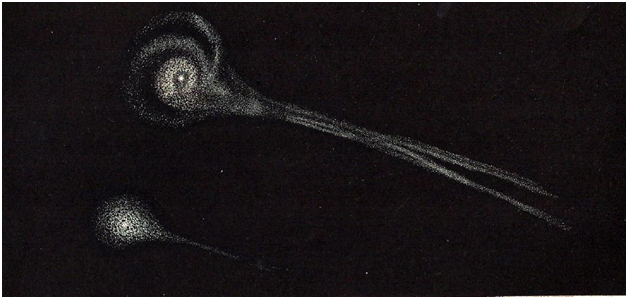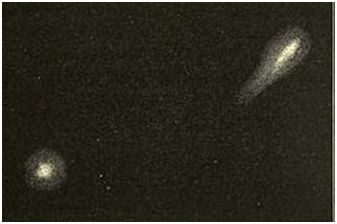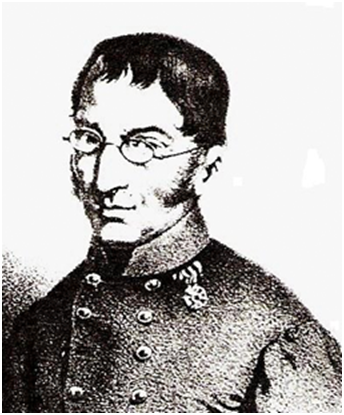3D/Biela
The story of comet Biela begins in 1772 when a comet was observed by Jaques Liebax Montaigne and the independently observed by Charles Messier. A further observation was made in 1805 by Jean-Louis Pons, but no connection was made between the two objects- enter Captain Wilhelm Von Biela (b; 10.03.1782, d; 18.02.1856).
Born in northern Germany, he was a descendent of a noble family originally from the Czech Republic.
He went on to study at military college in Dresden and graduated to join the Austrian army in 1802 as a cadet in the infantry regiment. He quickly rose through the ranks and became a Captain of Grenadiers and saw active service in battles against Napoleon between 1805 and 1809. In 1813 he was an Adjutant ( basically an assistant ) to General Marveldt at the battle of Leipzig where he was wounded.
His astronomical career began in 1815 when he went to Prague and became a specialist in observing and orbital calculation of Comets. We rejoin him in 1826 when he was awaiting a Comet that he was told maybe appearing by Joseph Morstadt which he believed may be the return of the Comets since 1772 and 1805. Bessel had computed orbits that linked these two Comets but later retracted his statement as he could not, for definite, conclude these were one and the same. Morstadt held faith though, and strongly believed Bessel was correct.
He was to be proved correct as Biela located the Comet on February 27th at mag 8.5 in Aries. Biela’s Comet brightened to just about naked-eye level at best and was observed for a total of 72 days, thus allowing the orbit to be determined to 6.7 yrs, and also to positively identify it with the Comets of 1772 and 1805.
The following return was picked up by John Herschel on 24/09/1832 at mag 8 and brightened up to mag 7 as the Comet approached Earth to a distance of 0.56 au. No tail was ever recorded and a coma was never reported exceeding 3’. The return of 1839 was missed due to an unfavourable position of the Comet and so next visual report comes in 1845 on November 26th when de Vico ( Rome ,Italy ) picked it up at a magnitude of 10.5. The fact it was fainter than predicted did not cause concern and the Comet then began brightening rapidly during December.
The fun began in mid-January 1846 when reports began to come in of the Comet being in two parts. The first report of this goes to Matthew Fontaine Maury of the U.S Naval Observatory, Washington and he reported a double nucleus on January 13th. The Comet continued to approach both Earth and Sun and the two nuclei pulled farther apart.
March saw observations noting the magnitude as 5.5 and by Months end the nuclei were 14’ apart which would represent an actual separation of the two parts is somewhere near aphelion in 1842. The following apparition was first noted on August 26th 1852 by secchi ( Rome ) at a mag of 7.5 and the fainter travelling companion was located on the 15th of September just 2 weeks before the Comet went into conjunction with the Sun and no further observations were offered of this rather unfavourable appearance.
Sadly the 1859 apparition was so unfavourable that no observation of it were made at all, but the 1865 apparition would be a fantastic one and astronomers were well prepared but the Comet was not to be seen and suspicion was the Comet had broken up and disintegrated completely. The 1872 approach was again very much favourable, but no detection was ever made, but on November 27th a completely unexpected Meteor shower was seen with rates of Meteors calculated at 3,000 an hour. This shower was a known related phenomena of Comet Biela, and so a German astronomer named Klinkerfaces estimated with this knowledge the predicted position of the Comet. The following predicted Comet returns of 1885,1892 and 1899 showed no Comet but huge Meteor showers were observed with rates for 1885 reaching 15,000 an hour of 1892, 6,000 an hour and 1899 just 150 an hour.
The Comet was never seen again.
Several searches have since been made for the remnant of Comet Biela, nuclei B no doubt disintegrated ,but fragment A could very well still exist as a asteroidal type object.
A definitive object that relates to Comet Biela is yet to be identified.
Orbital Data
Epoch: 29/9/1852
Discovery: 27/2/1826
Perihelion: 0.8606 au
Aphelion: 6.190 au
Semi-Major Axis: 3.5253 au
Eccentricity: 0.7559
Inclination: 12.550
Period: 6.619 Years
T-Jupiter: 2.531
Classification: Jupiter Family Comet.

The two components of comet Biela as drawn in February 1846, around two years after they separated at aphelion.

Sketch by Secchi, 1852

Wilhelm Von Biela
Neil Norman, Ipswich, England
back